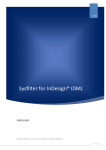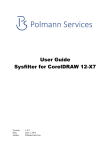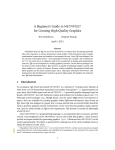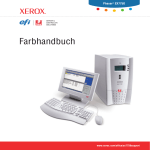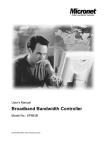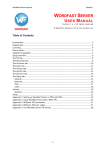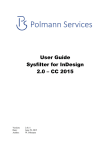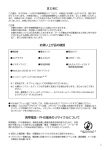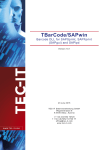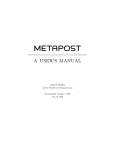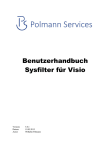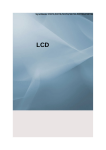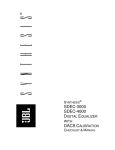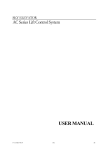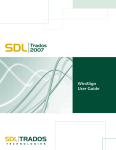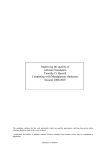Download Sysfilter for Illustrator® CS2-CC 2015
Transcript
User Guide 2015 Sysfilter for Illustrator USER GUIDE POLMANN SERVICES | St.-Lukas-Str. 36 86169 Augsburg Germany 1 User Guide User Guide Sysfilter for Illustrator® CS2-CC 2015 Version: Date: Author: 5.0.1 06/28/2015 PS Team Copying and publication is expressly prohibited without prior written consent. This information may be subject to changes or updates without specific notice. Copyright by Polmann Services - Jorge Polmann 2 User Guide 1 TABLE OF CONTENTS 1 Table of Contents ...................................................................................................... 3 2 General ....................................................................................................................... 6 3 Symbols and Notes ................................................................................................... 7 4 Installation Requirements......................................................................................... 8 4.1 4.2 4.3 5 Scope of delivery .................................................................................................. 8 License agreement ............................................................................................... 8 Installation ............................................................................................................ 9 Activate software ..................................................................................................... 10 5.1 Evaluate software / Trial version ........................................................................ 11 5.2 Registration ........................................................................................................ 11 5.2.1 Purchase software ...................................................................................... 11 5.2.2 Please send the "software code" to Polmann Services ............................... 12 5.2.3 Activate software ......................................................................................... 12 5.2.4 License transfer (only applicable for activated software) ............................. 13 5.2.5 Renewal of Sysfilter subscription: ............................................................... 14 5.2.6 Convert Sysfilter subscription into permanent license: ................................ 15 6 Operation ................................................................................................................. 16 6.1 Functions in the main view ................................................................................. 16 6.1.1 Selection of drives and directories .............................................................. 17 6.1.2 Selection of file types .................................................................................. 17 6.1.3 Selection of the files for export or import process. ...................................... 18 6.1.4 File processing options ............................................................................... 19 6.1.5 Operation of the pick lists: ........................................................................... 20 6.1.6 Change saving location and automatic creation of subfolders .................... 21 6.2 Tab: Export ......................................................................................................... 22 6.3 Tab: Import ......................................................................................................... 23 6.4 Tab: Concat. ....................................................................................................... 24 6.4.1 Concatenating and splitting - functions ....................................................... 26 6.4.2 Concatenate files ........................................................................................ 27 6.4.3 Split files ...................................................................................................... 28 6.5 Tab: Layers ........................................................................................................ 29 6.5.1 Rename text layers ..................................................................................... 29 6.5.2 "Remove layers" .......................................................................................... 30 6.6 Tab: Quality checks ............................................................................................ 30 6.6.1 Searching for overset text ........................................................................... 30 6.6.2 Point texts to path texts ............................................................................... 31 6.6.3 Replace fonts: ............................................................................................. 31 6.7 Tab: PDFs .......................................................................................................... 31 6.8 Tab: Conv. .......................................................................................................... 32 3 User Guide 7 Export process ........................................................................................................ 33 7.1 Export results ..................................................................................................... 35 7.2 Translation of the files ........................................................................................ 36 7.2.1 Export format DOCX, DOC or RTF ............................................................. 36 7.2.2 Notes on the translation of DOCX, DOC or RTF using Trados ................... 36 7.2.3 Tags ............................................................................................................ 37 7.3 Export format XML ............................................................................................. 38 7.3.1 Tag structure ............................................................................................... 38 7.3.2 30 Attributes of the element <CF> .............................................................. 38 7.3.3 Notes on the translation of the XML files ..................................................... 39 7.3.4 Notes on the translation of XML files using Trados ..................................... 40 7.4 Known Issues / note on formatting ..................................................................... 40 8 Import process ........................................................................................................ 41 9 Sysfilter Advanced Settings / Tools....................................................................... 43 9.1 "Settings" ............................................................................................................ 43 9.2 "Count" ............................................................................................................... 45 9.3 "Export options" .................................................................................................. 46 9.4 "Import options" .................................................................................................. 47 9.5 "QA Checks / Font Settings"............................................................................... 48 9.6 "EPS Save Options" ........................................................................................... 49 9.7 "General Options for PDF" ................................................................................. 50 9.8 Settings "Global PDF / Source and Target language PDF files"......................... 51 9.9 "Save Options" ................................................................................................... 52 9.10 "Config. file" ........................................................................................................ 53 9.10.1 Sysfilter-Save Settings ................................................................................ 54 10 Menu Functions ................................................................................................... 55 11 Recording of export and import processes in a log file. .................................. 56 12 Line/word count ................................................................................................... 56 12.1 13 Sylfilter text count and calculation function......................................................... 56 Tips and Tricks .................................................................................................... 59 13.1 Notes on layout works / DTP: ............................................................................. 59 13.2 Layers ................................................................................................................ 59 13.2.1 Selective text export of a layer .................................................................... 59 13.2.2 Rename text layers ..................................................................................... 60 14 Proofreading / Create PDF files .......................................................................... 60 15 Instructions Command Line Mode (CL Mode) ................................................... 61 15.1 Commands ......................................................................................................... 61 15.1.1 Commands for the export process to XML, DOC, DOCX or RTF:............... 61 15.1.2 Commands concerning the import process: ................................................ 62 15.1.3 Commands concerning the concatenation process..................................... 62 4 User Guide 15.1.4 Commands concerning the splitting process ............................................... 63 15.1.5 Layer handling (Tab: "Layers") .................................................................... 63 15.1.6 Quality checks: (Tab "QA Checks") ............................................................. 63 15.1.7 PDF Creation (Tab: "PDFs") ....................................................................... 64 15.1.8 Freehand conversion options in the "Conv." tab ......................................... 64 15.1.9 System Tray - Command line mode ............................................................ 64 15.1.10 Sample files / Batch, CMD files ............................................................... 65 15.2 Changing the CONFIG.XML file ......................................................................... 66 15.2.1 Modification using the Sysfilter User Interface ............................................ 66 15.2.2 Altering the configuration file manually ........................................................ 67 15.2.3 Default settings ........................................................................................... 67 15.2.4 Increase performance if the checkbox "Place tags into text- XML" is activated .................................................................................................................... 70 15.2.5 Configuration file IN COMMAND line Mode ................................................ 70 15.3 Running server tasks.......................................................................................... 71 15.3.1 Concerning Sysfilter .................................................................................... 71 15.3.2 Concerning Illustrator .................................................................................. 71 16 Technical Support................................................................................................ 72 17 Training................................................................................................................. 72 18 New Features ....................................................................................................... 73 19 Contact ................................................................................................................. 73 20 Copyright / Trademarks....................................................................................... 73 5 User Guide 2 GENERAL Sysfilter for Illustrator® is an efficient and user-friendly tool. It is the only filter tool worldwide providing 4 different methods of text transfer. Sysfilter for Illustrator® enables you to transfer texts from your Illustrator files to a word processor of your choice or to XML. After the texts have been edited, they will be automatically reinserted into the original document using the filter. SYSFILTER FOR ILLUSTRATOR ® Exports texts from Illustrator Re-imports texts automatically to the original Outputs Illustrator texts into other formats ● Counts characters and lines reliably Concatenates any number of files (several files are combined into one file) Sysfilter can be used for many applications. Translators as well as technical editors and DTP specialists will benefit from its advantages and its versatility. You may use translation memory systems during the translation job without any problems. At a glance: TRANSLATION: Automatic text transfer to XML, MS Word and other word processors (DOC, DOCX or RTF). Translation, spell check, and replacement of terms can be done in one single file. The Sysfilter count and calculation function enables you to calculate the translation price quickly. Compatible with most popular translation memory systems: Wordfast, Across, Déjà Vu Atril, SDL Trados, Star Transit TECHNICAL EDITORS: select specific Illustrator layer copy specific Illustrator layer rename specific Illustrator layer delete specific Illustrator layer automatically replace fonts, up to 4 fonts at once. replace fonts in one specific layer 6 User Guide DESKTOP PUBLISHING/ QUALITY CHECK: Merging of individual Illustrator documents to form one PDF file. Merging of translated Illustrator documents with the original to form a PDF file. The PDF files contain a link to the Illustrator files and can be opened with a single click. Automatically search for overset texts or cut-off texts. Convert point texts to path text. PDF, EPS ,AI save options. 30 of the most important text formats are preserved. AUTOMATION Control via command line 3 SYMBOLS AND NOTES It was one of our priorities to design this User Manual as clearly arranged as possible. We have marked notes that are particularly important or useful as follows: ☺ Notes to be observed specifically. Data security, risk of data loss, etc. Notes to be observed. Information on the duration of specific processes. Useful tips for your daily work. Enjoy reading the User Manual and working with your newly acquired Sysfilter. The users of the test version will also appreciate to read this Manual. Your Support Team 7 User Guide 4 INSTALLATION REQUIREMENTS To use Sysfilter for Illustrator the following software needs to be installed on your computer and run without problems: Adobe* Illustrator CS2 , CS3, CS4, CS5, CS5.1, CS6, CC, CC 2014 or CC2015 Recommended operating systems: Windows 7 or Windows 8* Sysfilter for Illustrator is for use with Microsoft's Windows operating systems up to version 8. On Windows ME, 98, NT and 2000 operating systems you might not be able to use the full functionality of Sysfilter for Illustrator. If you have any doubts, please try out the trial version. To guarantee full functionality of Sysfilter, we recommend, that you update your Microsoft and Adobe programs to the latest service releases. Programs marked with an asterisk (*) are programs of Microsoft Corporation or Adobe and not included in the delivery. Required disk space: approx. 30 MB 4.1 SCOPE OF DELIVERY Included within the scope of delivery: ● the file "setup-S4AI......exe " ● User Guide in PDF format 4.2 LICENSE AGREEMENT The use of Sysfilter is governed by license agreements. During the installation process the license agreements will appear on your desktop and you will be asked to read and accept them. 8 User Guide 4.3 INSTALLATION Installation is very easy. ☺ If you are an experienced users, just start the setup file and follow the instructions on the screen. The installation requires administrator rights. Installation process in detail: 1. Extract "setup-S4AI......exe "from the ZIP archive. 2. Copy the file "setup-S4AI......exe" to a folder on your hard disk. 3. Double-click on the file "setup-S4AI......exe" within your "Windows Explorer" to start the installation process. 4. Select a language. Here you can switch the language of the Sysfilter user interface to your preferred language (German, English or Spanish). The language setting can be changed any time. 5. License Agreements You will now be asked to accept or decline the license agreements. You will only be able to continue the installation process if you accept the license agreements. 6. Select the target folder. This folder is used to store the installation files. 7. Select the folder for the start menu. 8. Click on 'Complete' and Sysfilter for Illustrator will be started. Using the Windows start menu you can start Sysfilter at any later time. 9. After the start a Welcome Screen will be displayed. 9 User Guide 5 ACTIVATE SOFTWARE The full version of this program is activated with an activation key. A different software code is generated during each installation process. For detailed information about the activation please read the following chapters. Using the activation key you can install Sysfilter on one computer. If you buy a full version of Sysfilter we will send you an e-mail with your activation key. Use the "Info" command in the "?" menu to display the registration status of your software. If you launch the unregistered version of Sysfilter for Illustrator the activation screen is displayed: 10 User Guide You can select one of the following options: Test Software Registration 1) Purchase software 2) Please send the "software code" to Polmann Services 3) Activate software License transfer (only applicable for activated software) 5.1 EVALUATE SOFTWARE / TRIAL VERSION You may test Sysfilter during a period of 28 days at no charge and use of all functions. In the upper left corner a counter is displayed, which indicates how long the software can be started in testing mode. After the software is activated, instead of the counter the letter "A" is displayed. The trial version permits you to select a maximum of 10 files. In the export file, the term "trial version" is inserted. Some functions are restricted. 5.2 REGISTRATION If you want to use the full version without restrictions, please proceed as follows: 5.2.1 PURCHASE SOFTWARE Click the link "Purchase software" in the activation screen. The link will lead you to the Polmann Services website, where you can find detailed information about how you can order Sysfilter. Or you can simply purchase Sysfilter by sending us an e-mail or a fax including your order. e-mail: [email protected] The current contact data is provided on our website. Be sure to include your name, address, and email address. Or just order via the Online Shop on our website http://www.sysfilter.de 11 User Guide 5.2.2 PLEASE SEND THE "SOFTWARE CODE" TO POLMANN SERVICES After you have completed the ordering process, please send us the software code of your Sysfilter installation. Please click on the link "Please send the software code". An e-mail message will open automatically. The software code generated during installation will be displayed in the reference line. Simply send this email to [email protected]. Alternatively, you can copy the software code manually from the subjacent text field into an e-mail. 5.2.3 ACTIVATE SOFTWARE After we received your order and your software code, we will send you an activation key within 24 hours (on working days). For software activation please click the link "Activate software" in the activation screen. The following entry box will be displayed. Enter the activation key into the field "Activation key" and click on "Activate". A confirmation message will be displayed. The software is now activated! After the activation process has been completed without errors, the letter "A" will be displayed in the upper left corner of the activation screen. 12 User Guide 5.2.4 LICENSE TRANSFER (ONLY APPLICABLE FOR ACTIVATED SOFTWARE) If you want to install and use your already activated Sysfilter software on a new PC you have the possibility to transfer your license. If you transfer the license, the activation on your previous computer will be deleted. The software will be changed again into the test mode. On the target machine, the same Sysfilter version should be installed. A transfer using different versions is not supported. To transfer your license proceed as follows: 1. Start the Sysfilter program on your "old" computer. 2. To do so, go to the main menu and click "?" and then "Register software". The activation screen will be displayed. 3. Click the link "Transfer license". 4. Use the field "Enter software code of the target PC:" to enter the software code of the new PC. 5. After that click on the "Transfer license" button. 6. The bottom text field now shows the new activation key. 13 User Guide 7. Use this activation key to activate the software on the target PC. Note down this key or copy it into an e-mail. 5.2.5 RENEWAL OF SYSFILTER SUBSCRIPTION: To renew your Sysfilter subscription during the subscription period, proceed as follows: 1) In the Menu click on "?" --> "Register Software..." 2) Click on "Renew Sysfilter subscription" 3) Copy the newly released Software Key into a mail which you send to Polmann Services. We will send you an Activation Key. 4) Enter the Activation Key into the bottom field. 5) Click on the button "Activate". --> The Software subscription has been renewed! 14 User Guide 5.2.6 CONVERT SYSFILTER SUBSCRIPTION INTO PERMANENT LICENSE: To convert your Sysfilter subscription into a permanent license during the subscription period, proceed as follows: 1) In the Menu click on "?" --> "Register Software..." 2) Click on "Renew Sysfilter subscription" 3) Copy the newly released Software Key into a mail which you send to Polmann Services. We will send you an Activation Key. 4) Enter the Activation Key into the bottom field. 5) Click on the button "Activate". --> The software subscription has been converted into a permanent license! 15 User Guide 6 OPERATION The user interface of Sysfilter for Illustrator ® is easy to use. Follow your intuition. Sysfilter for Illustrator provides the following functions. 6.1 FUNCTIONS IN THE MAIN VIEW If Sysfilter for Illustrator ® is started you will see the main view first with activated "Export" tab (see below left). Main view with activated export options: 16 User Guide 6.1.1 SELECTION OF DRIVES AND DIRECTORIES Main view, top left On the top left display you can select the drives and directories which contain the files you want to edit. 6.1.2 SELECTION OF FILE TYPES By selecting the file type you determine which file or files you want to edit. The following options are possible: Main view, top right In addition to the displayed files any other files can be displayed. Just type another extension in the text box and press "Return". Wildcards can also be used. For example: * xxx * -> All files which contain "xxx" in the file name will be displayed. Before you start the export process click on Illustrator files (*.ai) or EPS files (*.eps). All AI or EPS files are displayed in the file list. Before you start the import process click on *.docx, *.doc, *.rtf or *.xml Click on All files (*.*). All files in the selected directory are displayed. 17 User Guide 6.1.3 SELECTION OF THE FILES FOR EXPORT OR IMPORT PROCESS. Select the files you want to process. For the export process the desired EPS files or AI files. For the import process the desired DOCX, DOC, RTF or XML files. IN THIS WAY YOU CAN SELECT THE FILES: Selection of a single file. Click on the file name to select a single file Multiple file selection: Click first file, then keep the control key pressed to select more than one file. Continuous file block: Click first file in the block. Scroll to the last file you want in the block, then hold down the shift key and click file. If you want to edit all files in the directory, click on "Select all". In addition files from subfolders can be selected. Activate the check box "Including subfolders". The file list will be updated and now also the files located in subfolders are displayed. File list (main view, center) Files from subfolders Files from subfolders can be selected and edited. The update process can be cancelled. The target files are saved during text transfer in the respective folder / subfolder. 18 User Guide 6.1.4 FILE PROCESSING OPTIONS Main view, buttons on the right side Selected files will be copied. Files will be pasted from the clipboard into the selected directory. Selected files will be copied to subfolders, and new subfolders will be created (see following Chapter). Windows Explorer will be opened. The current directory will be selected in the Windows Explorer. The file list will be updated. The files are deleted. The program will prompt to confirm the deletion. Please note that the files will be deleted not only in the Sysfilter view, but actually from the applicable directory. 19 User Guide 6.1.5 OPERATION OF THE PICK LISTS: - To open the pick list, click on the 3 dots next to the text box. Usually there are 4 icons available and the selection list with the appropriate entries. Meaning of the symbols from left to right: 1. Insert a new entry to the list 2. Edit entry 3. Delete entry 4. Add an entry to the text box. A list entry can be added to the text box by double-clicking. The pick list will be closed using the symbol "^". 20 User Guide 6.1.6 CHANGE SAVING LOCATION AND AUTOMATIC CREATION OF SUBFOLDERS Sysfilter for Illustrator® provides the following file management options for the project management tasks. For instance, you need not further manually create a folder for managing different language versions for every language and copy the work files separately to such folder. Sysfilter for Illustrator® will create up to 20 language folders to which it copies the desired files in one operation. How to proceed: In the main view click on the button in the button bar on the right side. The window "Create subfolders" will open: The files selected in the file list can be copied to another directory. Window "Create subfolders" A main folder can be selected. Up to 20 subfolders may be created. The files previously selected will be automatically copied to these folders. To initiate this, activate the applicable check box and enter a folder name. --> If the files are not to be copied, but only folders to be created, deactivate the box. 21 User Guide 6.2 TAB: EXPORT Several export options are provided: "Create PDF": During the export process PDF files of all selected Illustrator files are generated. File size will be kept as small as possible. The PDF files can be used as reference material during translation, proofreading and post layout processes. "Export hidden text": If this checkbox is activated hidden texts will be exported as well. "Create global PDF": A global PDF file can be created using this function. Using this function the selected documents can be concatenated to one file. The creation of the global PDF file is done during the export or import process. HOW TO PROCEED: 1. Select and mark files 2. Select the corresponding tab in the main view: "Export", "Import" 3. Enable the check box "Create global PDF". 4. Click on the respective button (export or import). Location of the file: Global PDF: In the current working directory of the main view, Name: Global PDF.pdf Batch settings up to 250 files per PDF, default setting: 120. (See also in the option window "Global PDF") "Only text from this layer" will be exported." Enter the layer name into the text box which contains texts you want to export. The export files contain only text from the selected layers. "and their sublayers" If this checkbox is activated, the texts of sublayers will be exported as well. "Place tags into text - XML": When transferring text the following format information is saved to the XML file: 1. Font name 2. Font size 3. Baseline shift 22 User Guide 4. BaselinePosition 5. BaselineDirection 6. Color black 7. Color cyan 8. Color magenta 9. Color yellow 10. Contextual ligature 11. Discretionary ligature 12. Alignment 13. Alternate glyphs 14. Auto leading 15. Capitalization 16. Italics 17. Kerning method 18. Language 19. Leading 20. Ligature 21. No break 22. Overprint 23. Overprint stroke 24. Rotation 25. Strike through 26. Stroke weight 27. Tracking 28. Underline 29. Horizontal scale 30. Vertical scale 6.3 TAB: IMPORT Several import options are provided: "Rename layer": Here you can rename a layer during the import process. In the upper field enter the name of the layer, which should be renamed. At the bottom enter the new name. 23 User Guide "Create PDF": PDF files of the selected Illustrator files can be created during import process. File size will be kept as small as possible. "Create PDF (source and target language)" Using this function, a PDF file can be created which contains original and translated Illustrator documents. Location of the file: In the current working directory, Name: AS-ZS-PDF.PDF "Create global PDF": A global PDF file can be created using this function. Using this function the selected documents can be concatenated to a single PDF file. The creation of the global PDF file is done during the export or import process. HOW TO PROCEED: 1. Select and mark files 2. Select the corresponding tab in the main view: "Export", "Import" 3. Enable the check box "Create global PDF". 4. Click on the respective button (export or import). Location of the file: In the current working directory of the main view, Name: Global-PDF.pdf Global PDF: Batch settings up to 250 files per PDF, default setting: 120. ☺ The PDF files can be used as reference material during translation, proofreading and post layout processes. The Illustrator files can be launched from the PDF file. Simply click on the appropriate links in the PDF files. 6.4 TAB: CONCAT. These functions enable you to concatenate the exported files into one single DOCX, DOC, RTF or XML file or into several batches and to split them again after translation. ☺ This time-saving solution is especially valuable for editors or translators working on projects with large file numbers. It is no longer necessary to open and close hundreds of files. Translation, spell check or replacement of terms can be done in one single file. 24 User Guide [Main view, "Concat." tab: "] 25 User Guide 6.4.1 CONCATENATING AND SPLITTING - FUNCTIONS 1. Selection of drive and directories File concatenation: Select the directory where the files you want to concatenate are located. Split: Select the directory where the concatenated file is located. 2. File list left: File selection. By default all files in the actual folder are selected, but it is also possible to specify individual files within that folder. Click on the file name to select an individual file. Multiple file selection: Click first file, then keep the control key pressed to select more than one file. Continuous file block: Click first file in the block. Scroll to the last file you want in the block, then hold down the shift key and click file. 3. File list, right: All files in the right-hand list box will be concatenated or split, no matter if they are highlighted or not. In this connection, it is irrelevant whether the files have been selected or not. FUNCTION OF THE BUTTONS: Include files to right-hand list box. Remove files from right-hand list box. Remove all files from right-hand list box. The files are not deleted, only removed from the list box. Move selected entry to the uppermost position. Move down selected entry (one position). Move down selected entry (one position). Move selected entry to the lowermost position. Move highlighted files using the mouse: Click one entry you want to move and then hold down the shift key while selecting further files. Continue to hold down the shift key and drag the selected files upwards or downwards in the list. 26 User Guide 6.4.2 CONCATENATE FILES HOW TO PROCEED: 1. Select tab page "Concat." 2. Option: Select "Concatenate as DOCX", "Concatenate as DOC", "Concatenate as RTF" or "Concatenate as XML". 3. Move files you want to cat to the right-hand list box Use function buttons to change file order if necessary. The sorting order of the files in the right-hand list box defines the file order of the resulting collective file. 4. You can change the file name of the resulting collective file here 5. Click on the "Concat." button. ☺ A subfolder named "Syscat" will be created in the current folder and the generated cat file will be saved in this folder This is the location where die batch file is with the concatenated files is stored. The current directory name is proposed as file name. Make the concatenated files appear in the batch file in the order most meaningful for your translation project. 27 User Guide 6.4.3 SPLIT FILES HOW TO PROCEED: 1. Select "Syscat:" tab 2. Option: Select "Split file (DOCX, DOC, RTF)" or "Split XML file". 3. Move desired files to the right-hand list box. 4. Click the "Split" button. [Split files] The files will be split and the resulting files are saved into the selected folder. 28 User Guide 6.5 TAB: LAYERS In the "Layers" tab, the functions "Rename Layer" and "Remove Layer" can be run independently from the export and import operation. For this purpose o select the desired files, o activate the appropriate check box and fill in the text fields o and click on "Action". 6.5.1 These actions should be performed before or after the text transfer, since the basic structure of the Illustrator document is changed. Sequence of actions when both check boxes are checked: First, the layers are renamed, then the specified layer is removed from the Illustrator document. RENAME TEXT LAYERS HOW TO PROCEED: 1. In the "Layers" tab activate the check box "Rename layer". 2. Enter then the appropriate layer name into the text fields or select one from the list "...". In the upper field enter the name of the layer, which should be renamed. At the bottom enter the new name. 3. Select files and click on "Action". ---> The relevant text layers of the Illustrator documents will be renamed. See also notes in the Sysfilter4Illustrator-Aktion.LOG file. 29 User Guide 6.5.2 "REMOVE LAYERS" HOW TO PROCEED: 1. In the "Layers" tab activate the check box "Remove layer". 2. Enter then the appropriate layer name into the text fields or select one from the list "...". 3. Select files and click on "Action". Selected text layer will be deleted. Select a layer from the combo box. 6.6 The layer name must match exactly the layer name of the document. Upper and lower case letters can be ignored. TAB: QUALITY CHECKS In the tab "QA checks" quality assurance and font replacement tasks can be performed. For this purpose ● select the desired files, ● activate the appropriate check box and fill in the text fields ● and click on "Action". The following options are available: 6.6.1 SEARCHING FOR OVERSET TEXT Text frames with overset texts are identified and listed in the LOG file. 30 User Guide 6.6.2 POINT TEXTS TO PATH TEXTS Point texts are converted to path texts. 6.6.3 Depending on how graphic texts were created in the Illustrator document minimal shifts of the text boxes can occur when converting them to paragraph text. REPLACE FONTS: Automatic replacement of fonts of the selected documents. Click on "List" to select the appropriate fonts. See also under chapter Options window – QA Checks / Font Settings. Only one layer can also be selected for the font substitution. 6.7 TAB: PDFS Using the "PDFs" tab either single or concatenated PDF files can be created. For this purpose ● select the desired files, ● activate the appropriate check box and fill in the text fields, ● and click on "Action". The following options are available: "Create PDF": PDF files of selected Illustrator files are generated. File size will be kept as small as possible. Make any other settings in the options window PDF Save Options. "Create global PDF": A global PDF file can be created using this function. Using this function the selected documents can be concatenated to a single PDF file. Location of the file: In the current working directory of the main view, Name: Global-PDF.pdf Global PDF: Batch settings up to 250 files per PDF, default setting: 120. "Create PDF (source and target language)": Using this function, a PDF file can be created which contains original and translated Illustrator documents. 31 User Guide ☺ 6.8 Select in the main view the corresponding EPS or AI files. Enter in the field "Target files" the folder with the translated EPS or AI files. A file is created containing the source language and target language files. Location of the file: In the current working directory of the main view, Name: AS-ZS-PDF.PDF The PDF files can be used as reference material during translation, proofreading and post layout processes. TAB: CONV. On the "PDFs" tab FreeHand files can be converted to Illustrator or EPS files using the default settings. For this purpose o select the desired files, o enable the appropriate text boxes, o and click on "Action". 32 User Guide 7 EXPORT PROCESS Sysfilter for Illustrator® exports and imports all texts from Illustrator ai files or eps files. Main view, "Export" tab HOW TO PROCEED: Select the folder in which the Illustrator CS files are located. The Illustrator files will appear. 1. Select "Illustrator-files (*.ai)" or "EPS-files (*.eps)" in the drop down combo box in the right corner. Click on "More options" -> "Settings" -> "Format of the export file" if you want to export text from Illustrator as DOCX, DOC, RTF or XML file. If you want to export the text of a certain layer, activate the check box "Only text from this layer" and enter the desired layer name. Check the box "and their sublayers" if you want to include the sublayers. Highlight the Illustrator CS files which contain texts you want to export. Click onto the "Export text" button to launch the export process. The progress bar appears now and the export process can be monitored. Illustrator will be started in the background. During export process you can minimize the Sysfilter window. 33 User Guide To avoid possible side effects, we recommend that you do not work on your computer during the importing and exporting process. If you already did an export process of a certain project and run a second export process Sysfilter for Illustrator will overwrite the existing files in this folder. Please make sure that you really want to overwrite the existing files before launching a second exporting process! You should NEVER use your original files for import or export processing, only copies. Take your time to save the original files and your translated files in a separate folder! After the export the following dialog appears: Back to main menu ☺ LOG file is displayed. Information about version, file number and settings. Quit Sysfilter There are additional options available for the export process. These can be found at: Tools >> Options ... >> Export options. See also under chapter 9: Sysfilter Advanced Settings / Tools 34 User Guide 7.1 EXPORT RESULTS The exported files are now in the same folder as the Illustrator files. The name of the export files consists of the name of the Illustrator files including the file extension ".ai" or ".eps". EXAMPLE: ILLUSTRATOR FILE NAMED "NAME.AI" File name (Illustrator) Export option: -> Standard settings Export file name Name.ai.docx Name.ai.doc Name.ai.rtf or Name.ai.xml -> "Create PDF" Name.pdf -> "Create file for count" (Only when DOCX, DOC or RTF were chosen as export format) -> Global PDF Count_ Name.ai.rtf A LOG file will be created automatically. Sysfilter4IllustratorExport.LOG Name.ai Global-PDF1.pdf EXAMPLE: EPS-FILE NAMED "NAME.EPS" File name (EPS) Export option: -> Standard settings Export file name Name.eps.docx Name.eps.doc Name.eps.rtf or Name.eps.xml -> "Create PDF" Name.pdf -> "Create file for count" (Only when DOCX, DOC or RTF were chosen as export format) -> Global PDF Count_ Name.eps.rtf Name.eps A LOG file automatically. will be Global-PDF1.pdf created Sysfilter4IllustratorExport.LOG 35 User Guide 7.2 TRANSLATION OF THE FILES 7.2.1 EXPORT FORMAT DOCX, DOC OR RTF The texts can be translated in Microsoft Word or other text editors. It is also possible to translate the texts using translation tools. ☺ 7.2.2 The files can be translated directly with the translation tool SDL Trados using MS Word without further pre-processing. Texts that must not be edited or translated are formatted as "tw4winexternal". NOTES ON THE TRANSLATION OF DOCX, DOC OR RTF USING TRADOS When the files are opened directly using TagEditor or the translation editor in SDL Trados Studio, undesired side effects may occur. It is possible that the formatting will be displayed incorrectly. To prevent this, we recommend the following practices: USING THE TAGEDITOR: For TTX creation, we recommend to choose the translation function of the workbench. (Activate the check box Tools Translate... Options Translation Memory Options... "TRADOStag XML Workflow for Workbench") USING SDL TRADOS STUDIO: - A project should be created for the translation and the translation should be done in the SDLXLIFF files. 36 User Guide 7.2.3 TAGS Please make sure that you don't change, delete or move the texts that are formatted in grey (filter information), otherwise errors will occur during the import process after translation. The filtering information is formatted as "tw4winExternal" and encapsulated between "<!—" and "-->". 37 User Guide 7.3 EXPORT FORMAT XML The files are saved in UTF8 format. These files can be translated using an XML editor or the Translation Tool of our choice. ☺ 7.3.1 Using the XML transfer allows you to maintain up to 30 important text formattings. This export method is particularly suitable for richly formatted Illustrator documents. TAG STRUCTURE The texts to be translated are located in the <cf> tag a child tag of the <text> element. The <CF> element is a child of the <p> and <sr>element. The <CF> element consists of 30 attributes with formatting information. 7.3.2 30 ATTRIBUTES OF THE ELEMENT <CF> ☺ The attribute values can be changed in the XML files, for example, by search and replace using a text editor. Example: Attribute value: Replace 0 with 11 Lang="0" (Language setting of the text: English) Lang="11" (Language setting of the text: Brazilian Portuguese) Attribute name size HTShift HTPos HTJap FCBlack FCCyan FCMagenta FCYellow Deutsch Font name Font size Hoch-/Tiefstellungen Hoch-/Tiefstellungen nach Position Hoch-/Tiefstellungen für Japanisch Farbe schwarz Farbe cyan Farbe magenta Farbe gelb English TextFont Font size BaselineShift BaselinePosition Variable type BaselineDirection Integer FCBlack - CMYKColor FCCyan - CMYKColor FCMagenta- CMYKColor FCYellow - CMYKColor Double String Double Double Integer Double Double Double 38 User Guide ConL DisL Align AGly AutL Capi HorS Ital KerM Lang Lead Lig NoBr OvPr OvSt Rot StriT StroW Trk Undl VerS 7.3.3 ☺ Kontextbedingte Ligaturen Bedingte Ligaturen Ausrichtung Alternative Glyphen Zeilenabstand (Automatik) Großschreibung Horizontal skalieren Kursiv Kerning Methode Language Zeilenabstand Ligaturen Kein Umbruch Fläche überdrucken Kontur überdrucken Drehen Durchstreichen Konturstärke Laufweite Unterstrichen Vertikal skalieren ContextualLigature DiscretionaryLigature Alignment AlternateGlyphs AutoLeading Capitalization HorizontalScale Italics KerningMethod Language Leading Ligature NoBreak Overprint OverprintStroke Rotation StrikeThrough StrokeWeight Tracking Underline VerticalScale Boolean Boolean Integer Integer Boolean Integer Double Boolean Integer Integer Double Boolean Boolean Boolean Boolean Double Boolean Double Long Boolean Double For a description of the allowed attribute values see the documentation from Adobe, under chapter "CharacterAttributes properties", page 20 onwards. Based on the above keywords the corresponding attribute properties can be found quickly. NOTES ON THE TRANSLATION OF THE XML FILES Elements (start and end tags) that are located within the <text> element, may be moved within the <text> element. For example: <p> and <sr>. Applies to elements that do not contain text to be translated: Please make sure that you don't change or delete the XML tags, otherwise errors will occur during the import process. It is more difficult to translate tagged files. A PDF file of the Illustrator document may be used as a reference file during the translation process. That is how the exported XML files look like, if opened using a text editor: 39 User Guide 7.3.4 NOTES ON THE TRANSLATION OF XML FILES USING TRADOS ☺ 7.4 Our download area provides an INI file for the Translation Tool SDL Trados. Or simply request by e-mail: mailto:[email protected] KNOWN ISSUES / NOTE ON FORMATTING Mixed formatting within a text object is not supported using the DOCX, DOC or RTF text transfer options of Sysfilter for Illustrator. The text formatting of the first character is applied to the whole text object. Using the XML transfer allows you to maintain up to 30 important text formattings. 40 User Guide 8 IMPORT PROCESS HOW TO PROCEED: Select the folder in which the translated files are located. The Illustrator files will appear. Select *.docx, *.doc, *.rtf or *.xml in the combo box in the right corner at the top. Select the import options you want. Highlight the files which contain the translations. Click onto the "Import text" button to launch the importing process. The progress bar appears now and the import process can be monitored. Illustrator will be started in the background. During the import process you can minimize the Sysfilter window. 41 User Guide To avoid possible side effects, we recommend that you do not work on your computer during the importing and exporting process. If you already did an import process of a certain project and run a second import process Sysfilter for Illustrator will overwrite the existing files in this folder. Please make sure that you really want to overwrite the existing files before launching a second exporting process! You should NEVER use your original files for import or export processing, only copies. Take your time to save the original files and your translated files in a separate folder! After the import the following dialog appears: Back to main menu LOG file is displayed. Information about version, file number and settings. Quit Sysfilter The Illustrator files now contain the translated texts. ☺ There are additional save and import options available for the import process. These can be found at: Tools >> Options... >> Save options or import options. See also under chapter 9: Sysfilter Advanced Settings / Tools ☺ Remember that automated filter processes require layout control and, depending on the file structure, post layout. ☺ PROOFREADING / CREATE PDF FILES During export and import process you can automatically create PDF files. The PDF files can be used as reference material for translation, proofreading or layout control. 42 User Guide 9 SYSFILTER ADVANCED SETTINGS / TOOLS How to activate the option window: Click on "More options" in the applicable tab or click on the menu "Tools" "Options...". 9.1 "SETTINGS" ● "Illustrator version" Sysfilter for Illustrator supports different versions of Adobe Illustrator. Select the desired Illustrator version from the combo box. ● "Enable 64 bit version for the filtering process" You can use Sysfilter for Illustrator with the 64-bit versions of Illustrator. To do so, enable the check box and enter the path to the "Illustrator.exe". 43 User Guide ☺ The corresponding Illustrator version must be installed on your system. Illustrator 64 bit versions are available since version CS6. The default path to Illustrator CS6 (64 bit) is: C:\Program Files\Adobe\Adobe Illustrator CS6 (64 Bit)\Support Files\Contents\Windows\Illustrator.exe The default path to Illustrator CC (64 bit) is: C:\Program Files\Adobe\Adobe Illustrator CC (64 Bit)\Support Files\Contents\Windows\Illustrator.exe The default path to Illustrator CC 2015 (64 bit) is: C:\Program Files\Adobe\Adobe Illustrator CC 2015\Support Files\Contents\Windows\Illustrator.exe "Format of the export file" Here you have the option to specify the format of the export file. You have the following choices: *.DOCX - MS Word *.DOC - MS Word *.RTF - MS Word *.XML (UTF8) Output format: DOCX Output format: DOC Output format: RTF Output format: XML, Unicode (UTF8) format "Activate Illustrator quick start" If Sysfilter accesses to Adobe Illustrator, Adobe Illustrator is usually closed after the access has been made. With this option enabled, Adobe Illustrator remains open and the Sysfilter processing is faster. 44 User Guide 9.2 "COUNT" Modify the settings of word count and price calculation according to your needs The LOG file contains information about the export process, the total character number, the number of lines (53 characters per line) and number of words. During export/import the counting and calculation information is written into the LOG file. To view the LOG file click onto "Show LOG file". 45 User Guide 9.3 "EXPORT OPTIONS" "Save source layer / Create new target layer" - In the Illustrator document a source language layer is copied. The copied layer gets a new name HOW TO PROCEED: 1. Field "Source Lang. Layer": Enter layer name 2. Field "New Target Lang. Layer": Enter new layer name ☺ Example of use: Field "Source Lang. Layer": German (this layer must be present in the Illustrator document) Field "New Target Lang. Layer": English (this layer will be created) A new layer called "English" shall be inserted into the Illustrator document before translation. In combination with the function export "Only text from this layer" texts can be exported or imported from this new layer. The source language layer is preserved and can serve as a translation template for future projects. 46 User Guide "Remove layer"- Selected text layer will be deleted. "Do not export texts from layers with language neutrality." Layers which are irrelevant for translation process are ignored. For example: Numbers or layers containing proper nouns. HOW TO PROCEED: Enter the layer names in the appropriate fields. "Create file for count" - A count file without tags is generated, which you can use for counting with your usual counting tool. You can use this file to determine the number of lines, characters or words using your customary character counting program. 9.4 You should never use count files for translation. After the export the count files will be located in the same folder as the Illustrator files. File name of count files: "count_dateiname.rtf". "IMPORT OPTIONS" "Remove all layers and respective sublayers, excepting:" Superfluous layers can be deleted from the Illustrator document. Enter the layer name that should not be deleted. Up to 5 layers may be selected. "Remove layer:" Selected text layer is removed. 47 User Guide 9.5 "QA CHECKS / FONT SETTINGS" "Font replacement" Select the fonts which should be replaced. The fonts will be replaced when performing the quality check actions. Up to 4 fonts per document can be replaced at once. Once you click on a text box the Illustrator fonts are loaded automatically to the pick lists. This may take a few seconds at the first loading. 48 User Guide 9.6 "EPS SAVE OPTIONS" Descriptions of the options correspond to the Illustrator EPS save options and can be found in the Adobe Illustrator documentation. 49 User Guide 9.7 "GENERAL OPTIONS FOR PDF" Descriptions of the options correspond to the Illustrator PDF save options and can be found in the Adobe Illustrator documentation. 50 User Guide 9.8 SETTINGS "GLOBAL PDF / SOURCE AND TARGET LANGUAGE PDF FILES" Changing the value of the box in the "Number of graphics" frame enables you to combine up to 250 files into a single PDF. The default setting is 120. Changing the value of the box in the "Number Graphics Source / Target Language" frame enables you to combine up to 100 files into a single PDF. The default setting is 50. 51 User Guide 9.9 "SAVE OPTIONS" Descriptions of the options correspond to the Illustrator save options and can be found in the Adobe Illustrator documentation. 52 User Guide 9.10 "CONFIG. FILE" Here you can save and load the Sysfilter settings or restore the default settings. The settings are stored in a file under the name Config.XML. The set Sysfilter options are stored in the file "Config.XML". This configuration file is a XML file that is stored in UTF8 format. It is located by default in the application path of the filter. The user interface of Sysfilter permits to change and store the set options in the configuration file: How to proceed: 1. Change desired options in the options area or in the main view. 2. Menu item: Select "Tools" --> "Options..." 3. Click on "OK". 53 User Guide 9.10.1 SYSFILTER-SAVE SETTINGS (1) (2) (3) (1) The XML configuration file may be stored at another location. (2) To restore the standard settings, click on "Reset settings to default". (3) External configuration file is activated. Whenever the program starts, Sysfilter will automatically load the external configuration file, whenever this check box is activated. ☺ The external configuration file may, for instance, be located on a network drive and used by several users. To prevent changes to the configuration file, the configuration file can be set read-only. 54 User Guide 10 MENU FUNCTIONS File Quit Projects Saves the path settings of the last 8 filtering projects. A time-consuming search for the preceding projects on your hard disk is not necessary. Just select your project from the project list to get to the directory you want. Tools Language. Here you can switch the language (English, German and Spanish) of the user interface to your preferred language. This setting will be retained after closing the program. Tools Options... . This opens the option window. Settings see chapter options windows. ? --> Information, Software registration 55 User Guide 11 RECORDING OF EXPORT AND IMPORT PROCESSES IN A LOG FILE. During export and import a LOG file is generated and saved in the current directory ("export.log" / "import.log"). The LOG file contains information about the process and errors that may have occurred. 12 You should check the LOG files after each export and import. The LOG file can be opened with any common text editor. LINE/WORD COUNT Sysfilter offers the following possibilities of text count: a) Sysfilter count and calculation function for text count and price calculation. b) Generation of a count file without tags, which you can count with your usual counting tool. 12.1 SYLFILTER TEXT COUNT AND CALCULATION FUNCTION Import and export process are documented in a LOG file. The log file contains information about import and export process as well as line count, word count and translation price calculation. Sometimes you might have found it difficult to calculate the translation price of a project including Adobe Illustrator ai-files/eps-files. The Sysfilter count and calculation function enables you to calculate the translation price during a simple export/import process. A plain export/import function provides you with a basis for your quotation costing. To use the Sysfilter count and calculation functions please proceed as follows. Go to the main menu and click on Tools --> Options… --> Count. The following screen will be displayed. 56 User Guide Option window "Count" Modify the settings of word count and price calculation according to your needs. During export/import the counting and calculation information is written into the LOG file. To view the LOG file click onto "Show LOG file". The LOG file contains information about the export process, the total character number, the number of lines (53 characters per line) and number of words. The LOG file ("export.log/import.log") is saved in the same folder as the Illustrator files. If you want to save the LOG file into a different directory, proceed as follows: Click on "Show log file" after the export/import is completed. Then click right mouse button. A file saving dialog will be displayed. The LOG file can be opened with any common text editor. 57 User Guide And that's what a Sysfilter LOG file looks like: 58 User Guide 13 TIPS AND TRICKS 13.1 NOTES ON LAYOUT WORKS / DTP: Due to the automation of text export and import Sysfilter Tools significantly reduce pre- and posttranslation formatting and layout expenses and thus help you to save a lot of time and money during translation process. Nonetheless you should consider that automated filter processes require layout control. 13.2 LAYERS Some Illustrator documents are structured so that the layer function of Illustrator is used to manage multiple language versions in a single document. You have the following possibilities for such documents using Sysfilter for Illustrator ®: 13.2.1 SELECTIVE TEXT EXPORT OF A LAYER 1. In the "Export" tab check the box "Only text from this layer". 2. A text box will appear where you enter the name of the layer to be exported or select the layer name from the pick list. The list permits to store layer names permanently and to retrieve them. 3. Make further settings according your needs and click on "Export Text". ---> The exported files contain the text of the selected layer. Import: The import function imports the texts automatically into the correct text frames. 59 User Guide 13.2.2 RENAME TEXT LAYERS 1. In the "Import" tab check the box "Rename Layer" 2. Text boxes will appear where you can enter the name of the layers or select the layer names from the pick list. In the upper field enter the name of the layer, which should be renamed. At the bottom enter the new name. The list permits to store layer names permanently and to retrieve them. 3. Make further settings according your needs and click on "Import Text". ---> The relevant layers of the Illustrator documents will be renamed. See also notes in the Sysfilter4Illustrator-Import.LOG file. 14 PROOFREADING / CREATE PDF FILES You can automatically create PDF files of the Illustrator files during the export or import process. Just activate the applicable check box under Export Options or Import Options. ☺ The PDF files can be used as reference material for translation, proofreading or layout control. 60 User Guide 15 INSTRUCTIONS COMMAND LINE MODE (CL MODE) The new command line function enables you to start Sysfilter by a batch-file or via command line or from other programs. By this means all export and import tasks can be accomplished automatically or at a designated moment for example on a server. Basics: 1. To shorten the path information the Sysfilter application the path can be added to the system path. (Default application path: "C:\Program Files (x86)\ecm\Sysfilter\IlluSysCC\S4IlUS.exe") --> Sysfilter can be started using the command line calling only the application name ("S4IlUS"): ...... 15.1 To start more than 3 instances at the same time, or to run the filter on a server a site license is required. COMMANDS 15.1.1 COMMANDS FOR THE EXPORT PROCESS TO XML, DOC, DOCX OR RTF: XML export: S4IlUS /c:\path /exp /xml /conf d:\path\config.xml DOC export: S4IlUS /c:\path /exp /doc /conf d:\path\config.xml DOCX export: S4IlUS /c:\path /exp /docx /conf d:\path\config.xml RTF export: S4IlUS /c:\path /exp /rtf /conf d:\path\config.xml Parameters: "/c:\path" - any folder, containing the EPS or AI files "/exp" - files will be exported "/xml", "/doc", "/docx" or "/rtf"- export format "/conf d:\path" -[optional: path to an external config file] Other export options depend on the settings in the 'config.xml' file. 61 User Guide 15.1.2 COMMANDS CONCERNING THE IMPORT PROCESS: XML import: S4IlUS /c:\path /imp /xml /conf d:\path\config.xml DOC import: S4IlUS /c:\path /imp /doc /conf d:\path\config.xml DOCX import: S4IlUS /c:\path /imp /docx /conf d:\path\config.xml RTF import: S4IlUS /c:\path /imp /rtf /conf d:\path\config.xml Parameters: "/c:\path" - any folder, containing the translated files "/imp" - files will be imported "/xml", "/doc", "/docx" or "/rtf"- Import format "/conf d:\path" -[optional: path to an external config file] Other import options depend on the settings in the 'config.xml' file. 15.1.3 COMMANDS CONCERNING THE CONCATENATION PROCESS XML concatenation: S4IlUS /c:\path /cat /xml /conf d:\path\config.xml DOC concatenation: S4IlUS/c:\path /cat /DOC /conf d:\path\config.xml DOCX concatenation: S4IlUS/c:\path /cat /DOCX /conf d:\path\config.xml RTF concatenation: S4IlUS/c:\path /cat /rtf /conf d:\path\config.xml Parameters: "/c:\path" - any folder, containing the files "/cat" - files will be concatenated "/xml", "/doc", "/docx" or "/rtf"- file format "/conf d:\path" -[optional: path to an external config file] A subfolder will be created named Syscat (Example "c:\path\SYSCAT"). The file name of the concatenated file is generated automatically and depends on the folder name. Other options depend on the settings in the 'config.xml' file. 62 User Guide 15.1.4 COMMANDS CONCERNING THE SPLITTING PROCESS XML splitting process: S4IlUS /c:\path /split /xml /conf d:\path\config.xml DOC- or DOCX splitting process: S4IlUS/c:\path /split /docs /conf d:\path\config.xml RTF splitting process: S4IlUS/c:\path /split /rtf /conf d:\path\config.xml Parameters: "/c:\path" - any folder, containing the concatenated files "/split" - files will be split "/xml", "/doc", "/docx" or "/rtf"- file format "/conf d:\path" -[optional: path to an external config file] Other options depend on the settings in the 'config.xml' file. 15.1.5 LAYER HANDLING (TAB: "LAYERS") Start layer actions: S4IlUS /c:\path /lay /conf d:\path\config.xml Parameters: "/c:\path" - any folder, containing the EPS or AI files "/lay" - layer handling: Options of the "Layer" tab are activated. Other options depend on the settings in the 'config.xml' file. "/conf d:\path" -[optional: path to an external config file] 15.1.6 QUALITY CHECKS: (TAB "QA CHECKS") Quality check actions: /c:\path /qm /conf d:\path\config.xml Parameters: "/c:\path" - any folder, containing the EPS or AI files "/qm" - QM Checks: Options of the "QA Checks" tab are activated. Other options depend on the settings in the 'config.xml' file. "/conf d:\path" -[optional: path to an external config file] 63 User Guide 15.1.7 PDF CREATION (TAB: "PDFS") PDF actions: S4IlUS /c:\path /pdfs /conf d:\path\config.xml Parameters: "/c:\path" - any folder, containing the EPS or AI files "/pdfs" - PDF creation: Options of the "PDFs" tab are activated. Other options depend on the settings in the 'config.xml' file. "/conf d:\path" -[optional: path to an external config file] 15.1.8 FREEHAND CONVERSION OPTIONS IN THE "CONV." TAB Freehand conversion: S4IlUS /c:\path /FH2AI S4IlUS /c:\path /FH2EPS Parameters: "/c:\path" - any folder, containing the EPS or AI files "FH2AI"- Freehand to Adobe Illustrator FH2EPS"- Freehand to EPS 15.1.9 SYSTEM TRAY - COMMAND LINE MODE When starting the filter via command line a small traffic light is displayed in the system tray. This indicates that the Sysfilter runs in the background. When the traffic light is clicked more options appear. 64 User Guide 15.1.10 SAMPLE FILES / BATCH, CMD FILES 1. Start-SYS-BatchMode.cmd: This kind of batch files calls Sysfilter one by one and will perform different tasks. Sample: @Echo Off Goto after Rem ############################################################################### Rem # Rem # Start process in batch mode Rem # Rem # Rem # Description: 1- Starts Sysfilter for Illustrator by the dos prompt Rem # -----------(Change the paths according your system) Rem # Rem # Copyright by Polmann Services Rem # All rights reserved.- File for free use. Rem # Rem ############################################################################### :after @Echo On Rem Task: Sample 1: Text Export EPS2XML Call "c:\YourApplicationPath\S4IlUS.exe" /e:\YourSamplePath\sample1\ /exp /xml /conf e:\YourSamplePath\sample1\config1.xml Rem Task: Sample 2: Text Export EPS2DOCX Call "c:\YourApplicationPath\S4IlUS.exe" /e:\YourSamplePath\sample2\ /pdfs /conf e:\YourSamplePath\sample2\config2.xml Rem Task: Sample 5: Quality Checks Call "c:\YourApplicationPath\S4IlUS.exe" /e:\YourSamplePath\sample5\ /qm /conf e:\YourSamplePath\sample5\config5.xml 2. Start-SYS-ParallelTasks.cmd: This batch file will execute multiple instances of Sysfilter and will perform different tasks. Sample: @Echo Off Goto after Rem ############################################################################### Rem # Rem # Rem # Rem # Description: 1- Starts Sysfilter for Illustrator by the dos prompt Rem # -----------(Change the paths according your system) Rem # Rem # Copyright by Polmann Services Rem # All rights reserved.- File for free use. Rem # Rem ############################################################################### :after @Echo On Rem Sample1: Export eps2xml Start c:\YourApplicationPath\S4IlUS.exe /e:\YourSamplePath\sample1\ /exp /xml /conf e:\YourSamplePath\sample1\config1.xml 65 User Guide Rem Sample2: Export eps2docx Start c:\YourApplicationPath\S4IlUS.exe /e:\YourSamplePath\sample2\ /exp /docx /conf e:\YourSamplePath\sample2\config2.xml Rem Sample3: Import xml2eps Start c:\YourApplicationPath\S4IlUS.exe /e:\YourSamplePath\sample3\ /imp /xml Rem Sample4: Import docx2eps Start c:\YourApplicationPath\S4IlUS.exe /e:\YourSamplePath\sample4\ /imp /docx Rem Sample5: QM Checks Start c:\YourApplicationPath\S4IlUS.exe /e:\YourSamplePath\sample5\ /qm /conf e:\YourSamplePath\sample5\config5.xml Rem Sample6: PDF creation Start c:\YourApplicationPath\S4IlUS.exe /e:\YourSamplePath\sample6\ /pdfs /conf e:\YourSamplePath\sample6\config6.xml ☺ 15.2 To see the results check the folders and log files. Only the Illustrator 32 bit versions should be used for parallel tasks. Further information about using batch files can be found on the following Microsoft page: http://www.microsoft.com/resources/documentation/windows/xp/all/proddocs/e n-us/batch.mspx?mfr=true CHANGING THE CONFIG.XML FILE The Sysfilter settings are stored in the "Config.XML"file. This configuration file is a XML file that is stored in UTF8 format. It is located by default in the application path of the filter or in the "C:\Users\Public\Documents\Sysfilter" folder of your system. There are 2 ways to alter the configuration file. 15.2.1 MODIFICATION USING THE SYSFILTER USER INTERFACE The user interface of Sysfilter permits to modify and save the settings of the configuration file: How to proceed: 1. Change desired options in the tools area or in the tabs of the main view. 2. Menu item: Select "Tools" --> "Options...". 3. Click on "Save Settings". The setting of the main view will be retained after closing the program. 66 User Guide 15.2.2 ALTERING THE CONFIGURATION FILE MANUALLY How to proceed: Open the corresponding config.xml using a text editor and edit the entries. 15.2.3 DEFAULT SETTINGS To restore the standard settings, click on "Reset settings to default". (Menu item: Tools --> Options...--> Configuration) <TAG>Value</TAG> Values / Description <?xml version="1.0" encoding="UTF-8" ?> <AICS2Config> <Application>Sysfilter for Illustrator ….e</Application> XML-Header Start-Tag Version Information <ApplicationVers>3</ApplicationVers> - Check the Illustrator version installed on your PC! Settings of the configuration file: <ApplicationVers>11</ApplicationVers> --> 10 stands for Illustrator CC 2014, --> 9 stands for Illustrator CC, --> 8 stands for Illustrator CS6, --> 7 stands for Illustrator CS5.1, --> 6 stands for Illustrator CS5, --> 5 stands for Illustrator CS4, --> 4 stands for Illustrator CS3, --> 2 stands for Illustrator CS2 <ApplicationVersIndex>0</ApplicationVersIndex> <ConfigPath></ConfigPath> <Startsettings>*.eps</Startsettings> no function no function Start settings for file selection: "*.eps" or "*.ai" <ExportCreatePDF>0</ExportCreatePDF> 0 = No action (default) 1 = PDF file creation (Export) <ExportVisible>0</ExportVisible> 0 = No action 1 = Export hidden text <CreateDok>0</CreateDok> 0 = No action (default) 1 = Create global PDF <ExportLayer>0</ExportLayer> 0 = No action 1= Only text from this layer <ExportLayerName></ExportLayerName> layer name <ExportSubLayerName>0</ExportSubLayerName> 0 =main layers 1= and sublayer 0 =no format tags 1= place tags into text -XML Import: 0 = No action (default) 1= rename layer Layer name Layer name 0 = No action (default) 1 = Create PDF / Import 0 = No action (default) 1 = Create source/target Lang. PDF Tab "Layers": 0 = No action (default) 1= Rename layer Layer name <ExportTagTextXML>1</ExportTagTextXML> <ImportRenameLayer>0</ImportRenameLayer> <ImportRenameLayerSource></ImportRenameLayerSource> <ImportRenameLayerTarget></ImportRenameLayerTarget> <ImportCreatePDF>0</ImportCreatePDF> <ImportCreateDokSourceTarget>0</ImportCreateDokSourceTarget> <LayersRenameLayer>0</LayersRenameLayer> <LayersRenameLayerSource></LayersRenameLayerSource> 67 User Guide <TAG>Value</TAG> Values / Description <LayersRenameLayerTarget></LayersRenameLayerTarget> <LayersDeleteLayer>0</LayersDeleteLayer> Layer name Tab "Layers": 0 = No action (default) 1= Delete layer Layer name 0 = No action (default) 1 = Searching for overset text 0 = No action (default) 1 = Point texts to path texts 0 = No action (default) 1 =Overset text 0 = No action (default) 1 = Create PNG files (Import and QM Checks) 0 = No action (default) 1 = Font replacement 0 = No action (default) 1 = Replace fonts only from this layer Layer name 0 = No action (default) 1 = Create PDF (Tab: PDFs) 0 = No action (default) 1 = Create source/target Lang. (Tab: PDFs) Path: Target files Price options Price options Price options Price options Save options: Save each Artboard to a Separate file EPS save options EPS save options EPS save options EPS save options EPS save options EPS save options <LayersDeleteName></LayersDeleteName> <qmchecksfonts>0</qmchecksfonts> <qmcheckstext>0</qmcheckstext> <qmchecksoverridden>0</qmchecksoverridden> <qmchkPNG>0</qmchkPNG> <qmchkFont>0</qmchkFont> <qmchkFontEbene>0</qmchkFontEbene> <qmchkFontEbText></qmchkFontEbText> <DoksCreatePDF>0</DoksCreatePDF> <DoksCreateDokSourceTarget>0</DoksCreateDokSourceTarget> <DoksCreateDokPath></DoksCreateDokPath> <OptionsPriceLine>1</OptionsPriceLine> <OptionsPriceWord>0,13</OptionsPriceWord> <OptionsPriceCharsPerLine>53</OptionsPriceCharsPerLine> <OptionsPriceCurrency>€</OptionsPriceCurrency> <OptionsEPSArtboard>0</OptionsEPSArtboard> <OptionsEPSPreview>1</OptionsEPSPreview> <OptionsEPSOverprint>0</OptionsEPSOverprint> <OptionsEPSEmbedAllFonts>1</OptionsEPSEmbedAllFonts> <OptionsEPSCompatibility>0</OptionsEPSCompatibility> <OptionsEPSEmbedLinkedFiles>0</OptionsEPSEmbedLinkedFiles> <OptionsEPSIncludeDocumentThumbnails>1</OptionsEPSIncludeDo cumentThumbnails> <OptionsEPSCMYKPostScript>0</OptionsEPSCMYKPostScript> <OptionsEPSCompatibleGradientPrinting>0</OptionsEPSCompatible GradientPrinting> <OptionsEPSPostScript>0</OptionsEPSPostScript> <OptionsAICompatibility>0</OptionsAICompatibility> <OptionsAISubset>100</OptionsAISubset> <OptionsAIEmbedLinkedFiles>0</OptionsAIEmbedLinkedFiles> <OptionsAIEmbedICCProfile>0</OptionsAIEmbedICCProfile> <OptionsAIPDFCompatible>1</OptionsAIPDFCompatible> <OptionsAICompressed>1</OptionsAICompressed> <OptionsAIartboard>0</OptionsAIartboard> <OptionsPDFSavePDFComp>0</OptionsPDFSavePDFComp> <OptionsPDFSavePDFStandard>0</OptionsPDFSavePDFStandard> <OptionsPDFSavePDFColBMI>5</OptionsPDFSavePDFColBMI> <OptionsPDFSavePDFGrayBMI>5</OptionsPDFSavePDFGrayBMI> <OptionsPDFSavePDFMonoBMI>3</OptionsPDFSavePDFMonoBMI > <OptionsPDFSavePDFPresEditC>1</OptionsPDFSavePDFPresEditC> <OptionsPDFSavePDFThumbnails>1</OptionsPDFSavePDFThumbna ils> <OptionsPDFSavePDFFastWV>0</OptionsPDFSavePDFFastWV> <OptionsPDFSavePDFCreatLay>0</OptionsPDFSavePDFCreatLay> <OptionsPDFSavePDFCreateMultiP>0</OptionsPDFSavePDFCreate MultiP> <OptionsPDFSavePDFcomprArts>1</OptionsPDFSavePDFcomprArts > <OptExpSettingsSaveASZS>0</OptExpSettingsSaveASZS> <OptExpSettingsSaveAS></OptExpSettingsSaveAS> <OptExpSettingsSaveZS></OptExpSettingsSaveZS> <OptExpSettingsSprNeutrLayers>0</OptExpSettingsSprNeutrLayers> <OptExpSettingssprNeutr0>0</OptExpSettingssprNeutr0> <OptExpSettingssprNeutr1>0</OptExpSettingssprNeutr1> EPS save options EPS save options EPS save options AI save options PDF save options PDF save options PDF save options PDF save options PDF save options PDF save options PDF save options PDF save options PDF save options PDF save options PDF save options 0 = No action (default) 1 = save source layer / create new target layer Layer name Layer name 0 = No action (default) 1 = Texts from layers with language neutrality 0 = No action (default) 1 = Texts from layers with language neutrality 0 = No action (default) 1 = Texts from layers with language neutrality 68 User Guide <TAG>Value</TAG> Values / Description <OptExpSettingssprNeutr2>0</OptExpSettingssprNeutr2> 0 = No action (default) 1 = Texts from layers with language neutrality Layer name Layer name Layer name 0 = No action (default) 1 = Texts for Deja Vu (only when using Microsoft Word ) 0 = No action (default) 1 = Texts without Tags (only when using Microsoft Word )) 0 = No action (default) 1 = Delete all layers excepting: 0 = No action (default) 1 = Delete layer Layer name 0 = No action (default) 1 = Delete all layers excepting: 0 = No action (default) 1 = Delete all layers excepting: 0 = No action (default) 1 = Delete all layers excepting: 0 = No action (default) 1 = Delete all layers excepting: 0 = No action (default) 1 = Delete all layers excepting: Layer name Layer name Layer name Layer name Layer name 0 = No action (default) 1 = Delete layer: (Export) Layer name 0 = No action (default) 1 = don't close Illustrator no function in command line mode 0 = No action (default) 1 = Font replacement 0 = No action (default) 1 = Font replacement 0 = No action (default) 1 = Font replacement 0 = No action (default) 1 = Font replacement Font name <OptExpSettingsTsprNeutrText0></OptExpSettingsTsprNeutrText0> <OptExpSettingsTsprNeutrText1></OptExpSettingsTsprNeutrText1> <OptExpSettingsTsprNeutrText2></OptExpSettingsTsprNeutrText2> <OptExpdv>0</OptExpdv> <OptExpcountfile>0</OptExpcountfile> <OptionsImpchkLayerImp>0</OptionsImpchkLayerImp> <OptionsImpchkLayerImpDel>0</OptionsImpchkLayerImpDel> <OptionsImpTextLayerDel></OptionsImpTextLayerDel> <OptionsImpsevLayerp0>0</OptionsImpsevLayerp0> <OptionsImpsevLayerp1>0</OptionsImpsevLayerp1> <OptionsImpsevLayerp2>0</OptionsImpsevLayerp2> <OptionsImpsevLayerp3>0</OptionsImpsevLayerp3> <OptionsImpsevLayerp4>0</OptionsImpsevLayerp4> <OptionsImpsevLayerImpText0></OptionsImpsevLayerImpText0> <OptionsImpsevLayerImpText1></OptionsImpsevLayerImpText1> <OptionsImpsevLayerImpText2></OptionsImpsevLayerImpText2> <OptionsImpsevLayerImpText3></OptionsImpsevLayerImpText3> <OptionsImpsevLayerImpText4></OptionsImpsevLayerImpText4> <OptionsImpchkLayerDel2>0</OptionsImpchkLayerDel2> <OptionsImpTextLayerDel2></OptionsImpTextLayerDel2> <OptionsGenchkIllStart>0</OptionsGenchkIllStart> <OptionsQMFontChk0>0</OptionsQMFontChk0> <OptionsQMFontChk1>0</OptionsQMFontChk1> <OptionsQMFontChk2>0</OptionsQMFontChk2> <OptionsQMFontChk3>0</OptionsQMFontChk3> <OptionsQMFontSearch0>ArialUnicodeMS</OptionsQMFontSearch0 > <OptionsQMFontSearch1>ICenter</OptionsQMFontSearch1> <OptionsQMFontSearch2></OptionsQMFontSearch2> <OptionsQMFontSearch3></OptionsQMFontSearch3> <OptionsQMFontReplace0></OptionsQMFontReplace0> <OptionsQMFontReplace1></OptionsQMFontReplace1> <OptionsQMFontReplace2></OptionsQMFontReplace2> <OptionsQMFontReplace3></OptionsQMFontReplace3> <OptionsGenchkGesDok>1</OptionsGenchkGesDok> <OptionsGenchkGesPDF>0</OptionsGenchkGesPDF> <OptionsgesPDFs>120</OptionsgesPDFs> <OptionsgesASZSPDFs>50</OptionsgesASZSPDFs> <MainSubfolder>0</MainSubfolder> <OptionsCHK64Bit>0</OptionsCHK64Bit> Font name Font name Font name Font name Font name Font name Font name no function no function Images per PDF file max.: Pairs source/target language per PDF max: 0 = No action (default) 1 = browse subfolders 0 = No action (default) 1 = activate use of Illustrator 64 bit version <Options64BitApplPath>…Illustrator.exe </Options64BitApplPath /> Path to 64 bit version </AICS2Config> Closing Tag 69 User Guide 15.2.4 INCREASE PERFORMANCE IF THE CHECKBOX "PLACE TAGS INTO TEXT- XML" IS ACTIVATED ☺ This chapter has become obsolete with Sysfilter for Illustrator version 5.0.1. The speed has been significantly improved in this version. The following entries in the Config.xml can be ignored. For compatibility reason these have not been deleted. <TAG>Value</TAG> <XMLexportColors>no</XMLexportColors> <XMLexportAlignment>no</XMLexportAlignment> Values / Description Obsolete Obsolete <XMLexportAlternateGlyphs>no</XMLexportAlternateGlyphs> Obsolete <XMLexportAutoLeading>no</XMLexportAutoLeading> Obsolete <XMLexportCapitalization>no</XMLexportCapitalization> Obsolete <XMLexportContextualLigature>no</XMLexportContextualLigature> Obsolete <XMLexportDiscretionaryLigature>no</XMLexportDiscretionaryLigature> Obsolete <XMLexportHorizontalScale>yes</XMLexportHorizontalScale> Obsolete <XMLexportItalics>yes</XMLexportItalics> Obsolete <XMLexportKerning>yes</XMLexportKerning> Obsolete <XMLexportLanguage>no</XMLexportLanguage> Obsolete <XMLexportLeading>no</XMLexportLeading> Obsolete <XMLexportLigature>no</XMLexportLigature> Obsolete <XMLexportNoBreak>no</XMLexportNoBreak> Obsolete <XMLexportOverprintFill>no</XMLexportOverprintFill> Obsolete <XMLexportOverprintStroke>no</XMLexportOverprintStroke> Obsolete <XMLexportRotation>yes</XMLexportRotation> Obsolete <XMLexportStrikeThrough>yes</XMLexportStrikeThrough> Obsolete <XMLexportStrokeWeight>no</XMLexportStrokeWeight> Obsolete <XMLexportTracking>no</XMLexportTracking> Obsolete <XMLexportUnderline>no</XMLexportUnderline> Obsolete <XMLexportVerticalScale>no</XMLexportVerticalScale> Obsolete 15.2.5 CONFIGURATION FILE IN COMMAND LINE MODE If the CONFIG file is not specified in the command line, the default CONFIG file is loaded from the application path. 70 User Guide 15.3 RUNNING SERVER TASKS 15.3.1 CONCERNING SYSFILTER There should be a time interval between calling the Sysfilter programs. About 3 to 5 seconds should be enough. XML export tasks and any XML import task with activated format tags option should not run parallel. Only in batch mode. Tasks with activated format tags option can save a lot of time for your DTP/layout department since more than 30 text formats can be transferred. Option in the configuration file: <ExportTagTextXML>1</ExportTagTextXML> 0 =no format tags 1= place tags into text -XML 15.3.2 CONCERNING ILLUSTRATOR Running different Illustrator versions at the same time could cause problems. So only tasks for the same Illustrator version should be started. Some folders of the latest task are blocked by Illustrator until Illustrator has quitted. Recommendation: Quit the Illustrator.exe if there is no Sysfilter instance running. Sysfilter can't close the Illustrator.exe to avoid interrupting other parallel tasks. Recommendation of Adobe: "Scripts that create, save, and close many Illustrator files should periodically quit and relaunch Illustrator. The recommended maximum number of files to process before quitting and relaunching Illustrator is: Windows 500 files" According to our filter experience up to 1000 files and more can be processed (open or saved) without any problems. 71 User Guide 16 TECHNICAL SUPPORT You will be provided with free support in our support forum on our website under http://www.sysfilter.de. Detailed information, sample files or screen shots especially the log file will help us process your request more quickly and accurately. Please make sure to include the following information: Operating system: Illustrator Version: Word Version: This will make it easier for us to respond to your request. Use the following e-mail address to get in touch with our support. e-mail: mailto:[email protected] 17 If you have any problems or questions concerning Sysfilter please first check this user guide or our support forum for help. Time-critical support requests cannot be answered under our free support. Inquire about our Special Support. TRAINING We will be glad to train you or your staff members. On site in your company or via the Internet by means of online sessions at your workplace. Inquire about our trainings – we will advise you. 72 User Guide 18 NEW FEATURES Sysfilter is continuously updated based on our tests and your suggestions. If you are already a customer, it will pay off for you to download the updated Sysfilter versions from our Download Centre on a regular basis smaller updates are available free of charge. 19 CONTACT Software & Development Wilhelm Polmann Telefon: 0049-(0)821-74785633 Online Shop: http://www.polmannshop.com/ mailto: [email protected] POLMANN SERVICES www.polmannservices.com Polmann Services Jorge Polmann St.-Lukas-Str. 36 86169 Augsburg 20 COPYRIGHT / TRADEMARKS Copying and publication of this document is expressly prohibited without prior written consent by Polmann Services - Jorge Polmann. This information may be subject to changes or updates without specific notice Adobe, Acrobat, Photoshop, InDesign and Illustrator are registered trademark of Adobe Systems Incorporated. All other trademarks (Microsoft, Visio, CorelDraw, Excel, SDL Trados, Déjà Vu Atril, Wordfast, Across, Transit, MemoQ) are the property of their respective owners. 73









































































